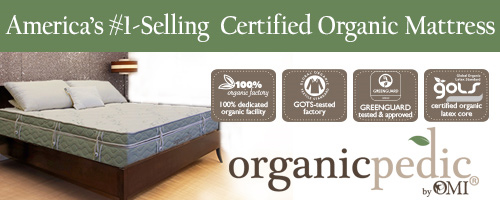Mattress Chemicals
and Health

Mattress Toxicity Information:
Child Mattress Emissions
Generate Concern
CHEM-TOX COMMENTS:
Over the past 50 years there has been a steady rise in the incidence
of children developing cancer and asthma. Logic and common sense would suggest that such a trend would be the result of changes in environmental factors that are now affecting our children that were not present previously. During this same 50 year period, consumer product manufacturers have found production costs can be substantially cut if natural materials are replaced with petroleum based alternatives made from synthetic chemicals.
Although this change has occurred in nearly every aspect of human life from home construction to food production to cosmetic ingredients, we need to first research factors that are in closest proximity to the child if investigating child related diseases. One such product would be the bedding materials used by a child.
For example, some crib mattresses are constructed of polyurethane foam
enclosed in vinyl covers. These plastic products are made by combining highly
toxic chemicals together to form the final material. During the sleep process, the child's every breath pulls in air that is literally inches away from the petroleum chemical materials used in the manufacturing of the bed itself. This process begins at birth and continues day after day during the child's critical development periods. With each breath, these chemical molecules are pulled across the child's airways and then transferred to the blood from deep within the lungs. This process is repeated with each breath 365 nights a year.
Now that it is widely accepted that child cancer and asthma can be caused or worsened by some petroleum chemical products, it is important to identify to what extent various chemical emitting products in bedding materials could be affecting a child's health.
Read Mattress Consumer Reviews & Concerns >>
The paragraph below is the abstract of a report addressing this issue and published
in the journal - Archives of Environmental Health, Jan/Feb, 2000.
Respiratory Toxicity of Mattress Emissions in Mice
"Groups of male Swiss-Webster mice breathed emissions of several brands of crib mattresses for two 1-hr periods. The authors used a computerized version of ASTM-E-981 test method to monitor respiratory frequncy, pattern, and airflow velocity and to diagnose abnormalities when statistically significant changes appeared. The emissions of four mattresses caused various combinations of upper-airways irritation (i.e., sensory irritation, lower-airways irritation (pulmonary irritation), and decreases in mid-expiratory airflow velocity. At the peak effect, a traditional mattress (wire springs with fiber padding) caused sensory irritation in 57% of breaths, pulmonary irritation in 23% of breaths, and airflow decrease in 11% of breaths. All mattresses caused pulmonary irritation, as shown by 17-23% of breaths at peak. The largest airflow decrease (i.e., affecting 26% of the breaths occurred with a polyurethane foam pad covered with vinyl. Sham exposures produced less than 6% sensory irritation, pulmonary irritation, or airflow limitation. Organic cotton padding caused very different effects, evidenced by increases in both respiratory rate and tidal volume. The authors used gas chromatography/mass spectrometry to identify respiratory irritants (e.g. styrene, isopropylbenzene, limonene) in the emissions of one of the polyurethane foam mattresses. Some mattresses emitted mixtures of volatile chemicals that had the potential to cause respiratory-tract irritation and decrease airflow velocity in mice."
SOURCE: Archives of Environmental Health, 55(1):38-43, 2000
Read Mattress Reviews & Testimonials >>
